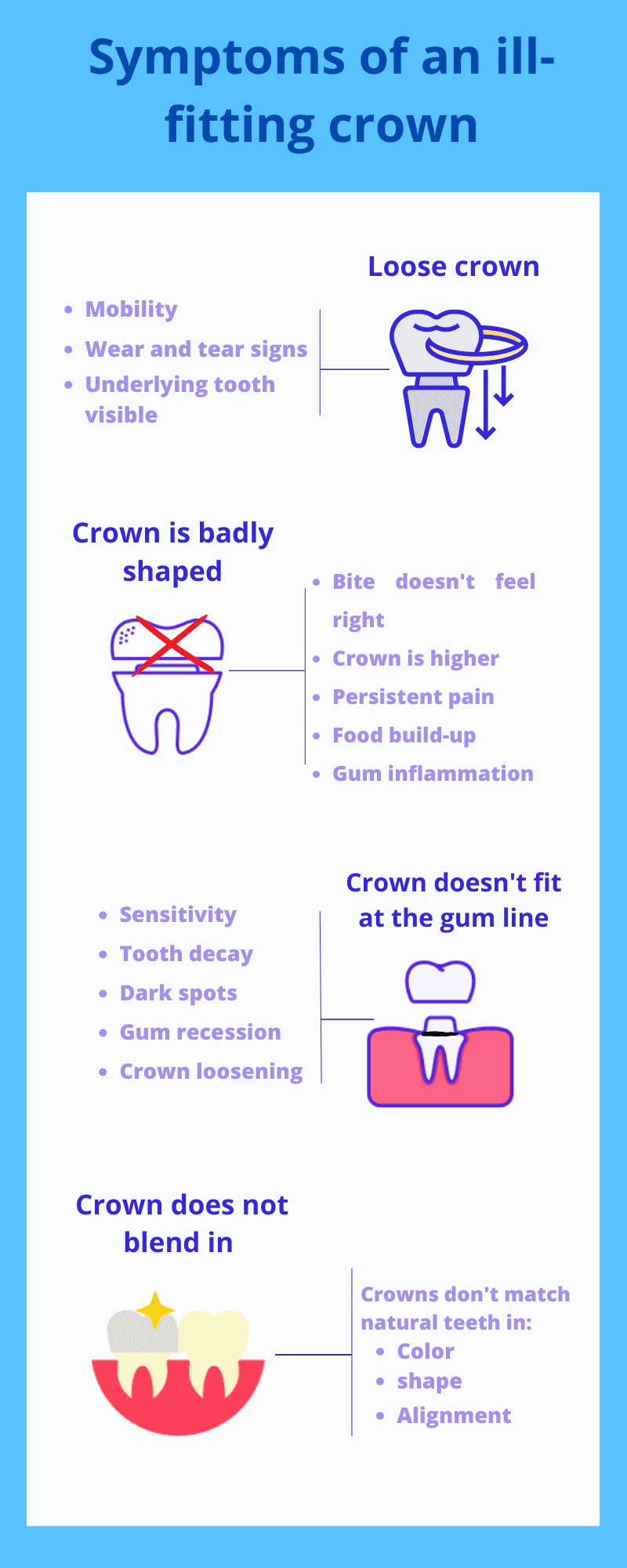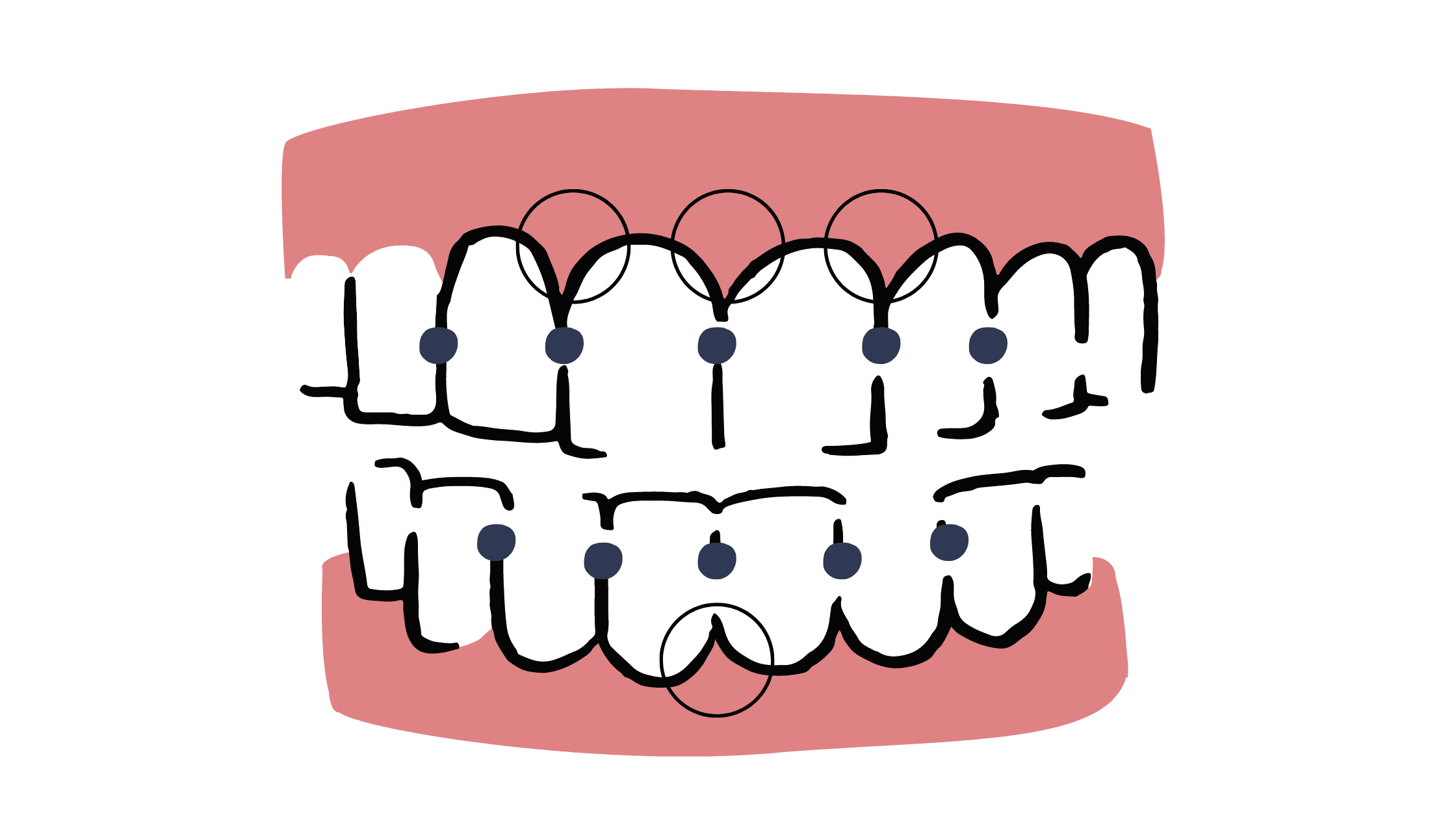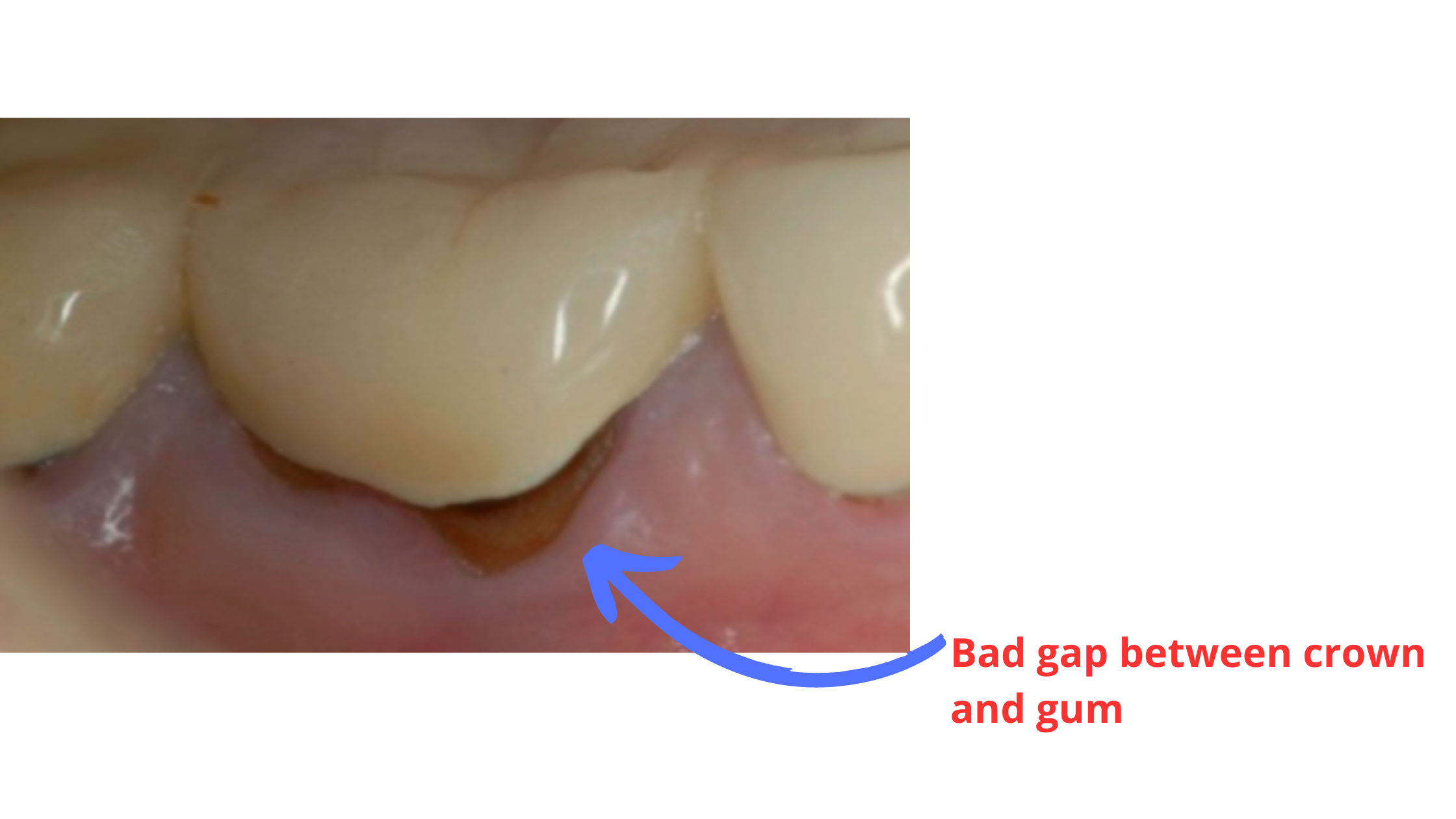Common symptoms of a bad fitting crown and its complications
 Dental crowns are a very successful procedure and a good option for restoring severely damaged teeth. They can last for years or even decades.
Dental crowns are a very successful procedure and a good option for restoring severely damaged teeth. They can last for years or even decades. However, if the crown does not fit the underlying tooth properly, its lifespan can be significantly reduced.
In this article, you will learn about the different symptoms of a poorly fitting crown and the most common causes and complications.
Table of content:
1. What are the most common situations when the dental crown does not fit properly?
2. The potential complications of dental crowns
3. What to do if my dental crown does not fit properly?
What are the most common situations when the dental crown does not fit properly?
After receiving your dental crown, it is normal to feel some temporary and reversible symptoms. For instance, you may feel that your bite does not feel right, your crown is too bulky, or you may experience some discomfort or slight pain.During the procedure, your tooth may be slightly irritated. This may result in soreness right after the numbness disappears. If this happens to you, remember that it is normal and should gradually subside during the first two weeks.
Furthermore, your mouth and bite will not immediately adapt to your new restoration. At first, you may feel like something is stuck in your teeth and have difficulty chewing your food, which is also completely normal.
It may take up to two weeks to fully adapt to your new crown.
However, some signs may indicate that something is wrong. Among the situations:
1. The crown is not attached properly:
The crown must be firmly attached to the tooth beneath it, without rocking or moving. Achieving this result depends mainly on the dentist's technique and laboratory work.On your side, you should avoid biting hard objects and maintain optimal oral hygiene. By doing so, you may never have to face this problem.
What can cause the crown to come off?
- You have put a lot of pressure on the crown by biting on a hard object.
- There was not enough cement to hold the crown in place.
- The remaining tooth structure is weak.
- The crown is poorly shaped or designed.
2. The crown is poorly shaped:
If the crown is not correctly shaped, you may feel that it is too high or puts too much pressure on the neighboring teeth.
A crown should be well aligned with the teeth so that chewing pressure is evenly distributed. It should also touch the neighboring teeth lightly without putting too much pressure on them. Poor contact between teeth can lead to food build-up and gum irritation.
The thickness of the crown also needs to be adjusted. A crown that's too bulky or too small can damage the gums and cause inflammation. Over time, this can lead to recession and bone loss.
Symptoms to look for:
If the crown is poorly shaped, you may notice that:
- Your bite does not feel right.
- You feel persistent pain when you chew or bite down.
- Food accumulates between your teeth.
- Your gums are irritated.
- You feel pressure in the neighboring teeth and your jaw.
- Your upper and lower jaws do not fit together properly. This can lead to tooth and joint pain over time.
3. The crown does not fit properly at the gum line:
When your dentist places the crown in your tooth, there should be no gap where bacteria and food particles can get in.The edges or margins of the crown, where it meets the underlying tooth, are often close to the gum line. This is often the first area to wear and damage if the crown doesn't fit properly.
Technically, the acceptable gap should be small and unnoticeable. If the gap is large or causes leakage, the crown is no longer suitable.

Food particles, saliva, and bacteria can seep through the open gap and damage the underlying tooth. The result is crown loosening, increased sensitivity, and infection.
However, don't confuse the “BAD” gap that causes leakage with the normal crown margin placement. Crown margins can sometimes be placed a little above the gum line, which can draw attention due to the contrast. As long as there's no leakage between the crown and the tooth, there's nothing to worry about. Your dentist may have preferred this margin position because it's gentler and easier to clean.
Symptoms to look for:
- Tooth decay.
- Sensitivity or pain in the teeth to hot or cold food or pressure.
- The appearance of a dark line near the gum line.
- The crown has become loose.
- Part of the underlying tooth is visible between the crown margin and the gum line (this could also be a sign of gum recession).
4. The crown on the front teeth does not look natural:
The symptoms of an ill-fitting front crown are similar to those mentioned above. What adds up is their aesthetic appearance, which is more important than the back teeth.The front teeth are the ones that are visible when you speak or smile.
They should blend in with your natural teeth and not look fake. Factors to consider include color, shape, surface texture, and alignment with other teeth.
A front tooth crown that does not look like neighboring teeth or feels unnatural in the mouth is considered a failure.
If you are not satisfied with the aesthetic results of your frontal crown, you can always talk to your dentist about making adjustments or redoing your crowns.
Porcelain is the material of choice for crowning front teeth, thanks to its natural tooth-like properties. However, it is also the most fragile and requires a greater thickness to prevent it from breaking under biting forces.
Today, there are various materials with the same natural-looking benefits as porcelain, but with greater resistance. These include E-max and translucent/highly translucent zirconia.
The potential complications of dental crowns
Dental crowns are designed to last as long as possible. This depends on the technique used, the type of crown (metal crowns last longer), and your oral hygiene.Although rare, complications can sometimes arise. According to one study (Journal of Prosthetic Dentistry), out of 1476 crowns, 157 (11%) were associated with complications. The most frequent were as follows:
- A need for root canal treatment (3%).
- Crown fracture (3%).
- Crown loosening and mobility (2%).
- Gum disease (0.6%).
- Cavities (0.4%).
1. The need for root canal treatment:
Crown placement and root canal treatment are two procedures that often go hand in hand. But this is not always the case. A crown can be placed on a tooth with healthy, living nerves.
A crowned tooth may need a root canal treatment (or retreatment) later if it develops an infection. This may be due to an untreated cavity that has progressed deeper or a tooth fracture.
Whatever the case, you should contact your dentist as soon as possible if you notice any of these symptoms:
- Redness around the crown.
- Severe pain.
- Pus discharge.
- Unpleasant smell coming from the crown.
- A cavity under the crown.
2. Crown fracture:
If the crown is too old, or if it's subjected to a lot of pressure, it can break and expose the underlying tooth. This is even more likely if you tend to bite on hard objects or grind and clench your teeth.
3. Crown loosening:
It's a common problem if the crown is not properly held over the tooth. As a result, the crown may keep coming off on its own or when you bite down on something. The first solution is to try to put the crown back in place after adding cement. If the problem persists or recurs, your dentist may redo the crown or recommend another option.
4. Gum disease:
If the crown is poorly shaped or extends beyond the gum line, it can irritate the gums and cause inflammation. This can cause the gums to recede, exposing part of the roots. Inflammation can also extend deeper and affect the bone and tissues that hold the tooth in place.
5. Cavities:
If a cavity is left untreated, or if there is a gap between the tooth and the crown, bacteria can work their way through the tooth and eat away at its hard layers. The tooth may then weaken and no longer be able to support the crown. At an advanced stage, you may end up losing your tooth.
The key to avoiding such complications is to always practice good oral hygiene and to visit your dentist regularly for check-ups to detect any problems early.
What to do if my dental crown does not fit properly?
It is normal to feel some pain or discomfort in your mouth after receiving your crown. You will need to be patient to give your tissues time to adapt.However, if you are not happy with the results or have noticed any signs of any of the above complications, you should see your dentist immediately. Some adjustments may be made, or if this is not possible, the crown may have to be redone.
- An overview of the dental pulp: its functions and responses to injury https://pubmed.ncbi.nlm.nih.gov/17546858/
- The Periodontal Crown: Creating Healthy Tissue https://www.dentistrytoday.com/sp-49455229/
- Clinical complications in fixed prosthodontics https://www.sciencedirect.com/science/article/abs/pii/S0022391303002142